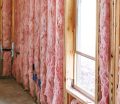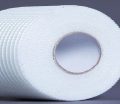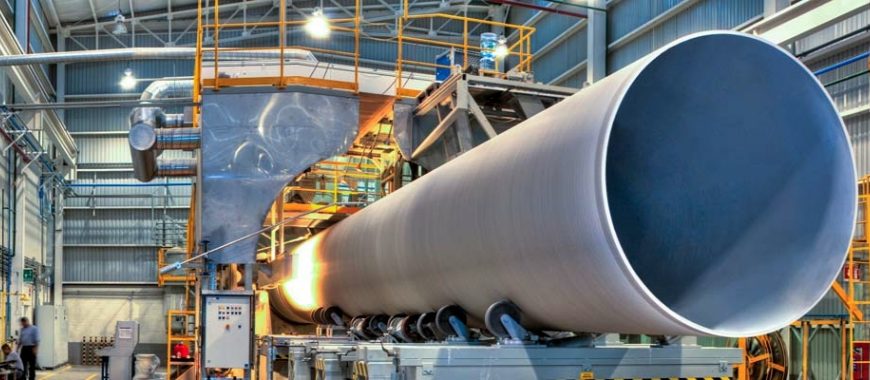
FRP (Fiberglass Reinforced Plastic) pipes are renowned for their strength, durability, and resistance to corrosion, making them a superior choice for many industrial applications. Discover lightweight GRP composite winding pipes with high strength and corrosion resistance for hot media conveyance and durability. These pipes are manufactured using a filament winding process, which involves winding fiberglass strands around a mandrel to create a robust, lightweight pipe. This method enhances the structural integrity and performance of the pipes. One prominent example is the China FRP winding pipe, which demonstrates the versatility and reliability of this technology. China FRP winding pipe has the characteristics of light weight, high strength, long service life . Excellent in corrosion resistance. These pipes are extensively used in industries such as chemical processing, where their ability to withstand harsh chemicals and high pressures is crucial. The filament winding technique ensures that these pipes offer exceptional performance and longevity in demanding environments.
Simplifying Your Life: Key Functionalities
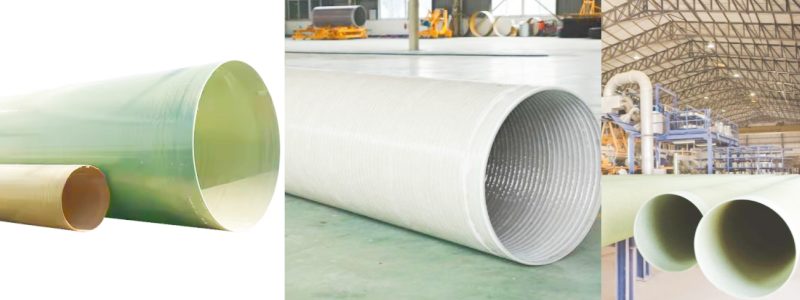
| Attribute | Description |
|---|---|
| Brand Name | GangLong Fiberglass |
| Place of Origin | Hebei Province, China |
| Material | Fiberglass Reinforced Plastic (FRP) |
| Technique | Filament Winding, Pultrusion Process, and Molding |
| Surface Treatment | Smooth Surface |
| Density | 1.7-1.9 g/cm³ |
| Application | High Voltage, Industrial, Power Supply, Water Transport |
| Features | - High Strength |
| - Dielectric Properties (Insulation) | |
| - High-Temperature Resistance (Grade B, F, H) | |
| - Stress Corrosion Resistance | |
| Standards | IEC, NEMA, ASTM |
| Certifications | ISO, ISO9001 |
| Processing Services | Decoiling, Molding, Welding, Punching, Cutting, Bending |
| Shape and Dimensions | Customized |
| Thickness | 0.5mm-10mm |
| Product Type | FRP Fiberglass Insulation Filament Winding Tube |
| Temperature Resistance | High temperature grades available (B, F, H) |
| Usage | Power Transmission, Industrial Equipment, Construction Materials, Water Transport Systems |
| Packaging | Custom packaging for safe transport |
| Supply Capability | Up to 100 pieces per day |
| Sample | Available |
| Advantages | - Easy Installation |
| - Multi-purpose Applications |
Description of China FRP Winding Pipe Pressure Water Pipes
FRP pressure water pipes are engineered to provide high performance in a range of demanding environments. These pipes are designed to handle high-pressure water applications, making them ideal for industrial uses where strength and reliability are paramount. The China FRP winding pipe exemplifies these features, offering a robust solution for transporting water under pressure. These pipes are particularly effective in settings that require both durability and resistance to harsh chemicals or extreme conditions.
Material Composition: FRP (Fiberglass Reinforced Plastic)
The primary material used in these pipes is FRP (Fiberglass Reinforced Plastic). This composite material combines fiberglass strands with a resin matrix to create a pipe that is both strong and lightweight. The fiberglass provides high tensile strength, while the resin binds the fibers together and enhances the FRP pipe tensile strength, improving the pipe’s resistance to various environmental factors. The combination of these materials ensures that the China FRP winding pipe maintains its integrity under stress and over time.
Manufacturing Process: Filament Winding
The filament winding process is crucial in the production of FRP pipes. In this process, continuous strands of fiberglass are wound around a rotating mandrel in a specific pattern. This technique allows for precise control over the pipe’s thickness and strength. The filament winding method used for the China FRP winding pipe involves wrapping the fiberglass in layers, each set at a particular angle to enhance the pipe’s overall strength and durability. The process is carried out using a GRP FRP pipe filament winding machine, which ensures precise control over the fiber orientation and resin application. This machine allows for the consistent production of GRP FRP pipe with optimal strength characteristics, making it ideal for a wide range of industrial applications where durability and performance are critical. Once the winding is complete, the resin is cured to harden the composite material, resulting in a pipe that exhibits exceptional performance characteristics.
Key Characteristics: Strength, Durability, and Corrosion Resistance
The key characteristics of FRP pressure water pipes, including the China FRP winding pipe, are their strength, durability, and corrosion resistance.
Strength: The filament winding process creates a pipe with a high strength-to-weight ratio, allowing it to withstand significant internal pressures without excessive material use.
Durability: These pipes are designed to last, even under harsh conditions. The composite material used in FRP pipes is highly resistant to wear and tear, making them a reliable choice for long-term applications.
Corrosion Resistance: One of the standout features of FRP pipes is their excellent resistance to corrosion. Unlike metal pipes, FRP pipes do not rust or degrade when exposed to moisture or chemicals, ensuring that the China FRP winding pipe maintains its functionality and appearance over time.
FRP pressure water pipes offer a combination of strength, durability, and resistance to corrosion, making them an excellent choice for various high-pressure applications. The filament winding process ensures that these pipes, including the China FRP winding pipe, meet the demanding requirements of industrial environments effectively.
China FRP Winding Pipe Standard Diameter
China’s FRP (Fiber Reinforced Plastic) Winding Pipe Standard Diameter defines the diameters for fiberglass-reinforced plastic pipes used in various industrial applications, including water supply, wastewater treatment, chemical transportation, and more. The standard diameter specifications are critical to ensuring consistency in manufacturing, ease of installation, and reliability in use. Below is a detailed breakdown of key aspects of the China FRP Winding Pipe Standard Diameter:
Standard Diameter Ranges
China’s standards typically cover a range of pipe diameters, ensuring compatibility across different applications and manufacturers.
Diameters generally start from smaller sizes, such as DN 50 mm, and extend to larger sizes like DN 4000 mm or more for industrial applications.
The range is designed to accommodate both low- and high-flow requirements across various industries.
Diameter Tolerances
Tolerance specifications dictate the allowable deviation from the nominal diameter, ensuring that pipes fit correctly with connecting components.
For smaller pipes (DN 50–200 mm), the tolerance may be more stringent, while larger pipes may have a slightly higher tolerance level.
Typical tolerance levels might range within ±0.5% to ±1% of the nominal diameter, depending on the specific diameter and application.
Application-Specific Standards
Different applications may require specific diameter adjustments based on pressure, temperature, and chemical compatibility.
For example, pipelines for chemical transport may have additional diameter standards to prevent leakage and ensure safety under corrosive conditions.
Standard diameters for water supply and drainage systems are optimized for ease of connection to existing infrastructure.
Wall Thickness in Relation to Diameter
China’s FRP Winding Pipe Standard includes specifications on wall thickness in relation to the pipe’s diameter.
For example, a DN 1000 mm pipe might have a wall thickness of 8 mm, while larger diameters require proportionally thicker walls to maintain structural integrity.
Wall thickness also affects the internal diameter, which can impact flow rates, so accurate specifications are essential for pipeline design.
Pressure Ratings and Diameter
Diameter standards are often paired with pressure ratings, as different diameters support different pressures.
The standard diameters accommodate multiple pressure classes, usually ranging from PN 0.6 MPa up to PN 2.5 MPa or higher for industrial use.
Pressure classes affect the pipe’s internal diameter as thicker walls are required to withstand higher pressures.
These standardized diameter specifications play a vital role in maintaining the quality, compatibility, and safety of FRP winding pipes used across various sectors in China.
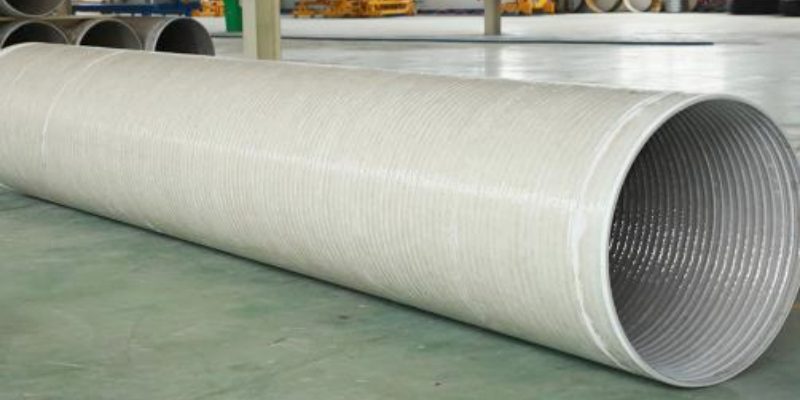
High Strength China FRP Winding Pipe
High-Strength China FRP (Fiber Reinforced Plastic) Winding Pipes are designed for demanding industrial applications where enhanced durability, corrosion resistance, and mechanical strength are essential. These pipes, made from fiberglass and resin, are manufactured using an advanced winding process, ensuring a precise balance of strength and flexibility. Below is a detailed overview of the characteristics, applications, and benefits of high-strength FRP winding pipes from China:
Material Composition
Fiberglass Reinforcement: The high-strength FRP winding pipes are reinforced with multiple layers of high-quality fiberglass, which enhances mechanical strength and impact resistance.
Resin Matrix: The fiberglass layers are bonded with a resin matrix, typically made of epoxy, vinyl ester, or polyester resin, chosen based on the specific environmental conditions the pipe will face.
Additives: Special additives, such as UV stabilizers and flame retardants, can be added to improve the pipe’s longevity and performance in harsh conditions.
Manufacturing Process
Filament Winding Technique: FRP winding pipes are produced through a filament winding process, where continuous fiberglass filaments are wound onto a rotating mandrel in multiple angles. This method provides optimal fiber orientation, which maximizes strength.
Controlled Resin Application: During winding, resin is carefully applied, ensuring uniform distribution across the layers. This precision reduces voids and weak spots, enhancing structural integrity.
Curing Process: Once winding is complete, the pipes undergo a controlled curing process, solidifying the resin and setting the final shape. Curing is essential to achieving the required high strength and durability.
Key Features of High-Strength FRP Winding Pipes
High Mechanical Strength: These pipes boast high tensile and flexural strength, making them suitable for high-pressure environments.
Corrosion Resistance: The resin matrix provides natural resistance to corrosion from acids, alkalis, and salts, making these pipes ideal for chemical and wastewater applications.
Lightweight Yet Durable: Compared to metal pipes, high-strength FRP pipes are lightweight, reducing transportation and installation costs while retaining high durability.
Temperature Tolerance: The material composition and design allow these pipes to operate in a wide temperature range, from sub-zero temperatures to high-heat environments.
Customizable for Pressure and Diameter: The winding process allows customization of wall thickness, diameter, and pressure class to meet specific project requirements.
Applications
Chemical Industry: Used in transporting corrosive chemicals and acids, where conventional metal pipes would degrade quickly.
Water Treatment and Desalination Plants: Ideal for handling brine and other highly corrosive fluids.
Oil and Gas: Deployed in onshore and offshore settings for both production and wastewater disposal pipelines, handling high-pressure and corrosive fluids.
Sewage and Wastewater Systems: Suitable for municipal systems requiring high-strength pipes to withstand both chemical exposure and mechanical load.
Marine and Offshore Applications: Corrosion-resistant and strong enough to withstand harsh marine environments, including seawater intake and discharge systems.
Advantages Over Traditional Materials
Corrosion and Chemical Resistance: Unlike metal pipes, high-strength FRP does not rust or react with most chemicals, reducing maintenance costs.
Long Service Life: Due to its durable construction, FRP has a service life of up to 50 years or more, making it a cost-effective investment.
Environmental Benefits: FRP pipes are more sustainable as they reduce the need for frequent replacements and are relatively energy-efficient to produce.
Ease of Installation: Being lightweight, they are easier to transport and install, reducing labor costs and installation time.
Quality Standards and Compliance
High-strength China FRP winding pipes typically comply with national and international standards, such as GB/T and ISO 14692, ensuring their performance and safety in critical applications.
These pipes undergo rigorous quality testing, including tensile strength tests, flexural strength assessments, and corrosion resistance evaluations.
Maintenance and Longevity
The pipes require minimal maintenance due to their resistance to most environmental factors.
Regular inspections are generally sufficient to ensure long-term performance, as the pipes are designed to withstand environmental and operational stresses without significant wear.
High-strength China FRP winding pipes are an excellent choice for industries that require robust, durable, and corrosion-resistant piping solutions. Their adaptable design, coupled with their light weight and long lifespan, makes them a sustainable and cost-effective option for challenging environments.
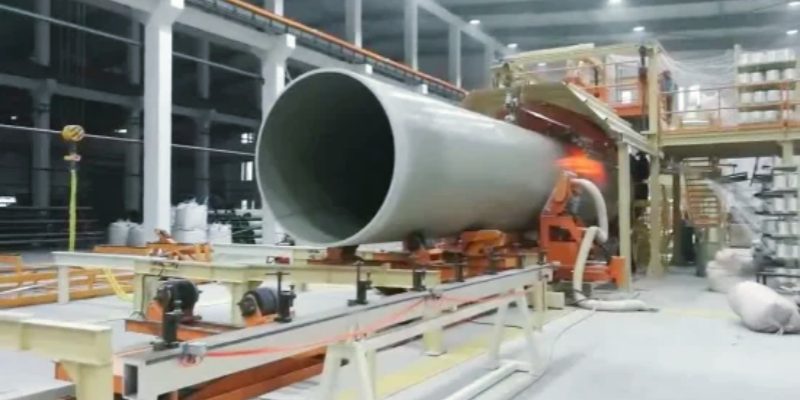
Underground China FRP Winding Pipe
Underground China FRP (Fiber Reinforced Plastic) Winding Pipes are specialized, corrosion-resistant pipes designed for installation below ground, primarily used in industries requiring durable, lightweight, and low-maintenance pipelines. Their unique properties make them ideal for applications in water supply, sewage, and other subterranean fluid transportation systems. Here’s an in-depth look at the features, manufacturing process, and benefits of underground FRP winding pipes from China:
Key Features of Underground FRP Winding Pipes
Exceptional Corrosion Resistance: FRP pipes are naturally resistant to corrosion from chemicals in the soil and groundwater, making them suitable for buried installations in various soil types.
High Mechanical Strength: These pipes are designed to withstand external soil pressure and the load from above-ground infrastructure, reducing the risk of collapse or deformation.
Low Permeability: The resin layer creates a low-permeability barrier, preventing contaminants from entering the pipeline or the transported fluid from leaching into the surrounding soil.
Lightweight and Easy to Install: FRP pipes are significantly lighter than traditional metal or concrete pipes, making them easier and more cost-effective to transport and install in underground systems.
Long Service Life: Properly installed underground FRP pipes can last upwards of 50 years, thanks to their durability and resistance to underground elements.
Applications
Potable Water Supply: Used in distributing clean drinking water, as FRP pipes resist chemical leaching and do not react with potable water.
Sewage and Wastewater Management: Ideal for sewage systems due to their resistance to corrosive wastewater and the gases often found in sewage environments.
Drainage Systems: Commonly used for stormwater and drainage systems due to their strength and ability to handle variable flow rates.
Chemical and Industrial Waste Transport: Suitable for underground pipes that transport chemicals or industrial waste, as FRP is resistant to chemical degradation.
Underground Oil and Gas: Used for transporting oil, gas, or associated water, especially in areas where corrosion from soil is a concern.
Advantages of Underground FRP Winding Pipes
Corrosion and Chemical Resistance: FRP pipes are ideal for harsh underground environments where soil acidity or chemical exposure could corrode metal pipes.
High Structural Integrity: The reinforced structure can handle ground movement and external pressures, reducing the risk of breaks or leaks.
Ease of Installation: Since FRP pipes are lightweight, they can be installed with fewer resources, reducing labor and machinery costs.
Environmental Sustainability: The pipes are durable and require minimal replacement or repair, which reduces environmental impact over time.
Cost Efficiency: With a long lifespan and low maintenance needs, underground FRP pipes provide a cost-effective solution compared to traditional materials.
Installation and Handling Considerations
Trenching Requirements: Trenches should be appropriately sized to prevent damage to the pipe during installation. Backfill materials must be compatible with FRP to prevent abrasion or excessive pressure.
Jointing Techniques: Joint types can include bell-and-spigot, mechanical couplings, or adhesive bonding, ensuring a tight seal to prevent leaks.
Compaction and Soil Load: After installation, the backfill material around the pipe must be compacted carefully to provide support and minimize movement over time.
Alignment and Slope: Proper alignment and slope are essential to prevent settling, which could disrupt flow and create pressure points on the pipe.
Underground FRP winding pipes from China offer a reliable, cost-effective, and long-lasting solution for a variety of underground applications. Their lightweight, corrosion-resistant design makes them ideal for potable water, wastewater, and chemical transport, providing a sustainable alternative to traditional metal or concrete pipes.
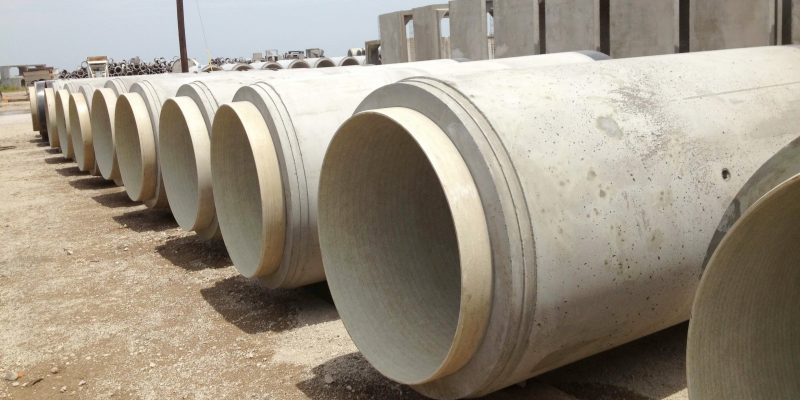
Applications of China FRP Winding Pipe
Usage in Chemical Industry
The China FRP winding pipe is particularly well-suited for applications in the chemical industry due to its exceptional resistance to corrosion and chemical damage. These pipes are designed to handle the harshest chemical environments without degrading or compromising their structural integrity. The FRP material used in these pipes can withstand aggressive chemicals, acids, and alkalis, making them ideal for transporting chemical solutions and waste products. For example, in chemical processing plants where traditional materials might fail due to corrosive substances, thechina frp winding pipe factories offers a reliable and durable solution, minimizing downtime and maintenance costs.
Applications for Water Transport and Underground Use
In addition to their use in chemical industries, FRP pipes are widely utilized for water transport and underground applications. The China FRP winding pipe, with its high strength-to-weight ratio, is perfect for transporting water under high pressure, whether in municipal water systems, irrigation, or industrial water supply networks. Their lightweight nature simplifies handling and installation, reducing labor and transportation costs compared to heavier materials like steel. Moreover, FRP pipes are resistant to biofouling and scaling, which helps maintain a clean and efficient flow of water over time.
Underground installations benefit greatly from the durability of FRP pipes. They resist soil corrosion and are less susceptible to damage from ground movement or external pressures, making them an excellent choice for buried pipelines. These pipes also have a low thermal conductivity, which helps in maintaining the temperature of the transported fluids, further enhancing their efficiency in various environmental conditions.
Specific Case Studies or Examples
Chemical Plant Installations: At a major chemical manufacturing facility, the China FRP winding pipe was selected for its ability to handle high concentrations of sulfuric acid. The pipes demonstrated remarkable resistance to chemical attacks and provided a long-lasting solution for the plant’s piping needs.
Municipal Water Supply: In a large urban water supply project, FRP pipes were used to replace aging steel pipelines. The China FRP winding pipe’s lightweight and corrosion-resistant properties significantly extended the lifespan of the system and reduced maintenance requirements.
Underground Utilities: For a major infrastructure project involving underground utilities, FRP pipes were chosen for their resistance to soil corrosion and their ability to handle varying soil conditions. The installation of China FRP winding pipes helped ensure a reliable and maintenance-free operation.
These applications highlight the versatility and effectiveness of FRP pipes in various demanding environments, reinforcing their value in both chemical processing and water transport systems.
China FRP Winding Pipe Product Listings on GangLong Fiberglass
| Category | Description |
|---|---|
| Overview of Available Filament Winding FRP Pipes | The China FRP winding pipe offers a diverse range of options suitable for various applications. GangLong Fiberglass features numerous listings for these pipes, highlighting their versatility and adaptability. |
| High Strength FRP Large Diameter Pipes | These pipes are designed to handle substantial internal pressures and are ideal for heavy-duty applications. They provide enhanced strength and durability for demanding environments. |
| Fiberglass Winding GRP Pipes with Fittings | This category includes FRP pipes that come with pre-fitted components, making installation easier and more efficient. The fittings ensure a secure and reliable connection, reducing the risk of leaks. |
| Various Diameters and Lengths | GangLong Fiberglass lists FRP pipes in a range of diameters and lengths, catering to different project requirements. This flexibility allows for customization based on specific needs and site conditions. |
| Fire Retardant and High-Pressure Options | Specially designed FRP pipes that meet fire retardant standards and are capable of withstanding high-pressure environments are available. These pipes are suitable for applications where safety and pressure resilience are critical. |
The China FRP winding pipe listings on GangLong Fiberglass provide a comprehensive selection of products tailored to various industrial needs, ensuring that users can find the right solution for their specific applications.
China FRP Winding Pipe Manufacturing Details
Continuous Filament Winding Process
The manufacturing of the China FRP winding pipe involves a highly specialized technique known as continuous filament winding. This process begins with the preparation of a rotating mandrel, which is coated with a release agent to facilitate easy removal of the finished pipe. Fiberglass filaments are then continuously wound around the mandrel in a predetermined pattern, typically using a helical or hoop winding technique. The filaments are impregnated with a resin, such as polyester or vinyl ester, during the winding process. This resin cures to form a strong, rigid composite material.
The continuous filament winding process is key to achieving the high strength and durability of the China FRP winding pipe. By precisely controlling the angle and tension of the filaments, manufacturers can tailor the mechanical properties of the pipe to meet specific performance requirements. This process ensures a uniform thickness and consistent quality across the entire length of the pipe, providing enhanced structural integrity and resistance to internal pressures and environmental conditions.
Range of Sizes and Customization Options
One of the significant advantages of the China FRP winding pipe is its versatility in terms of size and customization. FRP pipes can be produced in a wide range of diameters, from small, flexible pipes to large-diameter pipes suitable for major industrial applications. The customization options extend beyond just diameter; they include length, wall thickness, and resin type, allowing for tailored solutions to meet specific project needs.
Manufacturers offer various customization options, including different types of resins for specific chemical resistances, as well as varying filament winding patterns to enhance the pipe’s performance for particular applications. This flexibility makes FRP pipes highly adaptable for a wide range of uses, from municipal water systems to chemical processing plants and underground utilities.
Comparison with Other Manufacturing Techniques
Compared to other manufacturing techniques, such as pultrusion and fiberglass hand lay-up, the continuous filament winding process offers several distinct advantages.
Strength and Consistency: Filament winding produces pipes with superior strength and uniformity due to its controlled winding patterns and continuous process. In contrast, hand lay-up methods can result in inconsistencies and weaker points in the material.
Efficiency and Speed: The continuous nature of filament winding allows for the rapid production of long pipe lengths with minimal labor compared to the more labor-intensive pultrusion and hand lay-up methods.
Cost-Effectiveness: Although the initial setup for filament winding equipment can be costly, the efficiency and high production rate generally lead to lower per-unit costs for large quantities of pipes. This contrasts with the often higher labor and material costs associated with hand lay-up methods.
The China FRP winding pipe, produced through the continuous filament winding process, offers an excellent combination of strength, durability, and customization, making it a superior choice for many demanding applications.
Customization Options for China FRP Pipe Saddle Explained
China FRP Winding Pipe Pricing and Ordering
How to Find Pricing Information
To find pricing information for the China FRP winding pipe, there are several key steps you can follow:
Visit Supplier Websites: Many suppliers, including GangLong Fiberglass, provide pricing details on their official websites. Check the product listings for the China FRP winding pipe to find price ranges and options.
Request Quotes: For the most accurate and up-to-date pricing, contact suppliers directly to request a quote. Provide specific details about your needs, such as pipe dimensions, quantities, and any special requirements. This will help suppliers offer a tailored quote that reflects your exact needs.
Use Online Marketplaces: Platforms like GangLong Fiberglass list various FRP pipe products and often include pricing information. However, keep in mind that prices listed on these platforms can vary based on order quantities and supplier negotiations.
Consult Industry Reports:Industry reports and market analysis can provide insights into average pricing trends for the China FRP winding pipe and China FRP sand pipe.These resources can help you gauge whether a quote is competitive and reasonable.
Typical Price Ranges and Factors Affecting Cost
The cost of the China FRP winding pipe can vary widely based on several factors:
Diameter and Length: Larger diameter pipes and longer lengths generally cost more due to the increased material and manufacturing complexity. For instance, high-strength FRP pipes with large diameter fiberglass pipe are typically priced higher than smaller, standard pipes.
Resin Type: The choice of resin can significantly affect the price. Pipes made with premium resins, such as vinyl ester or phenolic resins, may cost more due to their superior properties, including enhanced chemical resistance and durability.
Customization: Customized FRP pipes, including those with specific filament winding patterns or special coatings, will generally have higher costs compared to standard options. Customizations might be necessary for applications requiring particular performance characteristics.
Quantity: Bulk orders often benefit from volume discounts. Suppliers may offer reduced unit prices for large orders, so it’s advantageous to negotiate pricing based on your project’s scale.
Additional Features: Pipes with added features, such as fire retardant properties or high-pressure ratings, may command higher prices. These features provide additional safety and performance benefits but also contribute to the overall cost.
Ordering Process and Lead Times
The ordering process for the China FRP winding pipe involves several steps:
Determine Requirements: Clearly define your project requirements, including pipe dimensions, resin types, quantities, and any special features. This information is crucial for obtaining accurate quotes and ensuring that the pipes meet your needs.
Contact Suppliers: Reach out to suppliers such as GangLong Fiberglass with your specifications. You can do this through their contact methods listed on their website, such as email or phone.
Receive and Review Quotes: Suppliers will provide a detailed quote based on your requirements. Review the quote to ensure it includes all necessary components and meets your budget.
Place an Order: Once you agree to the terms, place your order. Confirm the specifications and delivery details with the supplier to avoid any misunderstandings.
Lead Times: The lead time for manufacturing and delivery of the China FRP winding pipe can vary based on factors like order size and customization. Typical lead times range from a few weeks to several months. Be sure to discuss expected delivery dates with the supplier to align with your project schedule.
By following these steps, you can effectively manage the pricing and ordering process for the China FRP winding pipe, ensuring you receive a product that meets your project’s requirements while optimizing cost and delivery time.
Solutions from a Trusted Wholesale FRP Anticorrosion Pipe Factory
Conclusion on China FRP Winding Pipe
Recap of Key Advantages of Filament Winding FRP Pipes
The China FRP winding pipe represents a significant advancement in pipeline technology, offering numerous advantages over traditional materials. One of the key benefits is its exceptional strength, achieved through the continuous filament winding process. This technique ensures that the pipes are both strong and lightweight, capable of handling high pressures while remaining easy to transport and install.
Durability is another critical advantage. The FRP material used in these pipes is highly resistant to corrosion, making them ideal for use in harsh environments, such as chemical processing plants and underground utilities. The China FRP winding pipe also offers excellent resistance to various chemicals and extreme temperatures, enhancing its performance and lifespan in demanding applications.
Additionally, FRP pipes are designed to be low-maintenance. The filament winding process creates a uniform and consistent structure, reducing the likelihood of weaknesses or failures. This leads to lower maintenance costs and extended service life, contributing to overall cost savings for users.
Final Recommendations for Choosing the Right Pipe for Your Needs
When selecting the appropriate pipe for your project, it is essential to consider several factors to ensure that the China FRP winding pipe meets your specific requirements.
Assess Your Application: Determine the environmental conditions and operational demands your pipes will face. For applications in aggressive chemical environments or high-pressure systems, the China FRP winding pipe’s corrosion resistance and strength make it a top choice.
Consider Customization Needs: If your project requires pipes with specific dimensions, resin types, or additional features, explore the customization options available. Tailoring the China FRP winding pipe to fit your exact needs can enhance performance and longevity.
Evaluate Cost and Budget: Compare pricing information and consider factors such as diameter, length, and additional features that may affect cost. Bulk orders or customized solutions may offer cost advantages, so negotiate with suppliers to find the best value for your investment.
Review Supplier Reputation: Choose reputable suppliers, such as GangLong Fiberglass, who offer high-quality products and reliable customer support. Ensuring that you work with experienced manufacturers will help guarantee the performance and reliability of your FRP pipes.
By considering these factors and leveraging the strengths of the china frp winding pipe manufacturers, you can make an informed decision that ensures the success of your project and maximizes the benefits of this advanced piping technology.
China FRP Winding Pipe Manufacturers, Suppliers, and Factories Overview
china frp winding pipe manufacturers
GangLong Fiberglass – GangLong Fiberglass is a leading manufacturer of fiberglass reinforced plastic (FRP) winding pipes, renowned for their durability, corrosion resistance, and thermal stability. They offer customized FRP pipe solutions tailored to diverse industrial and construction needs, adhering to strict quality standards.
China National Building Material Group Corporation (CNBM) – A major manufacturer of FRP winding pipes, known for their robust performance and reliability in various applications.
Jiangsu Jiuding New Material Co., Ltd. – Specializes in producing a wide range of high-quality FRP pipes and fittings, serving various industrial and construction sectors.
china frp winding pipe suppliers
GangLong Fiberglass – GangLong Fiberglass is a distinguished supplier of fiberglass reinforced plastic (FRP) winding pipes, known for its exceptional product quality and customer-focused solutions. FRP pipes are ideal for various industrial and construction applications, with a focus on custom solutions and strict quality standards.
Hengshui Jintong Pipeline Engineering Co., Ltd. – Specializes in supplying FRP winding pipes with innovative designs and strong performance, catering to diverse industrial requirements.
china frp winding pipe factory
GangLong Fiberglass excels in manufacturing fiberglass reinforced plastic (FRP) winding pipes, renowned for their superior durability and resistance to corrosion and extreme temperatures.
Zhejiang Huadong Plastic Co., Ltd. – A renowned factory producing advanced FRP winding pipes with a focus on innovation and quality. Their products are designed for high durability and performance across various industrial applications.
Shandong Zhongjie Composite Material Co., Ltd. – Specializes in manufacturing FRP winding pipes with a strong emphasis on reliability and customization, serving diverse sectors with high-quality solutions.
Call to Action
If you’re ready to explore the benefits of the China FRP winding pipe for your project, we encourage you to reach out to suppliers for more detailed information. Whether you need a quote, have specific requirements, or want to discuss customization options, contacting suppliers is the best way to get precise and tailored solutions.
For comprehensive details on the China FRP winding pipe, including product specifications, pricing, and availability, visit the following links:
GangLong Fiberglass: Visit Website for information on their FRP products and to request a quote.
Contacting suppliers directly will also allow you to discuss any unique needs you may have and receive expert advice on the most suitable FRP pipe solutions for your specific application. Don’t hesitate to leverage the expertise of these manufacturers to ensure you select the right China FRP winding pipe for your needs.
Fiberglass Reinforced Plastic Decking Safety Tips
FAQs about China Frp Winding Pipe
FRP (Fiberglass Reinforced Plastic) and GRP (Glass Reinforced Plastic) pipes are often used interchangeably, but they have distinct characteristics. FRP pipes are a broader category of composite pipes that use various types of reinforcing fibers, including glass, carbon, or aramid fibers, combined with a resin matrix. GRP pipes specifically refer to FRP pipes that use glass fibers as the reinforcing material.
The primary difference lies in the type of reinforcement used: FRP pipes may use different fibers depending on the application’s requirements, whereas GRP pipes are strictly reinforced with glass fibers. This distinction impacts their strength, chemical resistance, and overall performance. For instance, GRP pipes typically offer high strength and durability for standard applications, whereas FRP pipes with other reinforcements might be tailored for more specific needs, such as enhanced chemical resistance or higher mechanical strength. Both types are lightweight, corrosion-resistant, and suitable for various industrial applications.
FRP (Fiberglass Reinforced Plastic) and PVC (Polyvinyl Chloride) pipes differ significantly in their composition and performance characteristics. FRP pipes are composite materials made from reinforcing fibers (such as glass) embedded in a resin matrix. This construction provides FRP pipes with high strength, durability, and resistance to corrosion and extreme temperatures. They are suitable for demanding applications like chemical processing and high-pressure systems.
In contrast, PVC pipes are made from a plastic polymer and are known for being cost-effective, lightweight, and easy to install. However, PVC pipes are generally less resistant to high temperatures and harsh chemicals compared to FRP pipes. They are commonly used for residential and light industrial applications. While PVC pipes are affordable and have good corrosion resistance for many environments, FRP pipes offer superior performance in more challenging conditions, including higher pressures and corrosive environments.
FRP (Fiberglass Reinforced Plastic) piping refers to a type of pipe made from a composite material consisting of fiberglass reinforcement embedded in a plastic resin. This combination creates a material that is strong, lightweight, and resistant to various environmental factors. The fiberglass provides structural strength and durability, while the resin offers resistance to corrosion, chemicals, and temperature extremes.
FRP piping is used in a wide range of applications, including chemical processing, water treatment, and industrial systems. It is particularly valued for its high strength-to-weight ratio, making it easier to handle and install compared to metal pipes. Additionally, FRP pipes are resistant to rust and corrosion, which prolongs their lifespan and reduces maintenance needs. This makes FRP piping an ideal choice for applications where traditional materials like steel or copper may not perform as well.
The pressure rating of FRP (Fiberglass Reinforced Plastic) pipes can vary depending on several factors, including the type of resin used, the reinforcing fibers, and the pipe’s diameter and wall thickness. Generally, FRP pipes are designed to handle a range of pressures, with some high-pressure variants capable of withstanding pressures up to 1500 psi (pounds per square inch) or more.
For typical applications, FRP pipes are available with pressure ratings that accommodate standard operating conditions, such as those found in municipal water systems, chemical processing, and industrial settings. It is essential to select FRP pipes with a pressure rating suitable for your specific application to ensure safety and reliability. Manufacturers usually provide detailed specifications for their FRP pipes, including pressure ratings, to help you choose the right product for your needs. Always consult the manufacturer’s guidelines and verify that the chosen FRP pipe meets the required pressure specifications for your application.
FRP (Fiber Reinforced Plastic) pipes typically have a life expectancy of 30 to 50 years, making them a durable choice for industries like water treatment, chemical processing, and oil and gas. However, this lifespan can vary based on factors such as the specific materials used in the FRP composition, environmental conditions, and the quality of installation and maintenance practices. For instance, FRP pipes exposed to harsh chemicals or extreme temperatures may experience faster degradation, while those in controlled environments may last longer. Regular maintenance and proper handling during installation can significantly extend the lifespan of FRP pipes, making them a cost-effective option for applications requiring long-term reliability. Their lightweight nature also contributes to easier transportation and installation, further enhancing their appeal for use in a range of industrial and municipal infrastructure projects.
FRP pipes, despite their strength and durability, can present several issues. One primary concern is their vulnerability to stress cracking and impact damage, especially if they are mishandled during transportation or installation. Additionally, FRP materials can degrade over time if exposed to ultraviolet (UV) radiation, requiring protective coatings or barriers when used outdoors. Another potential problem is the quality of the joints and fittings, as improper installation can lead to leaks or failures at these points, compromising the pipe’s overall performance. In highly corrosive environments, certain types of FRP may also degrade faster than expected if not selected correctly for the specific application. Due to these challenges, careful consideration of FRP pipe specifications, protective measures, and professional installation is essential to avoid performance issues.
While FRP materials offer numerous advantages, they also come with some drawbacks in construction applications. Firstly, FRP tends to be more expensive than traditional materials like steel or concrete, making it less accessible for budget-sensitive projects. Secondly, FRP is susceptible to damage from impact, meaning it must be handled with care during transportation and installation to avoid cracks or structural weaknesses. Additionally, if FRP does become damaged, repairs can be complex and costly compared to other materials, as specific techniques and expertise are required. FRP also has limited resistance to high temperatures, which may restrict its use in certain applications. Furthermore, FRP is sensitive to UV light, which can cause surface degradation if not properly coated, adding to the maintenance requirements. Due to these factors, FRP may not always be the ideal choice for construction.
FRP stands for Fiber Reinforced Plastic, a composite material that combines a plastic resin matrix with fiberglass fibers for reinforcement. This combination provides a strong, durable material used in a variety of applications, particularly in industries where corrosion resistance and lightweight properties are essential. FRP pipes are created by embedding fiberglass into a plastic resin, such as epoxy, polyester, or vinyl ester, which results in a highly corrosion-resistant and lightweight pipe with excellent strength. These properties make FRP suitable for transporting various types of fluids, including water, chemicals, and wastewater, especially in environments where traditional materials may corrode or degrade. The development of FRP technology has provided industries with a valuable alternative to traditional metal and PVC piping systems, offering greater longevity in challenging conditions.
Yes, FRP pipes are generally stronger than PVC pipes, particularly in terms of tensile and impact strength. The fiberglass reinforcement in FRP gives it a higher tolerance for pressure and makes it more resistant to impact and deformation under stress compared to PVC. This enhanced strength also allows FRP pipes to be used in high-pressure applications, where PVC might fail or become deformed. Furthermore, FRP pipes are more resistant to corrosion and can handle a broader range of temperatures, making them suitable for more demanding industrial applications, such as chemical processing or oil and gas transport. However, with this increased strength comes a higher cost, as FRP is typically more expensive than PVC. The choice between FRP and PVC will depend on the specific needs of the project, including budget, environment, and pressure requirements.
There are several types of FRP pipes, each made with specific resins to suit different industrial requirements. The three main types include Epoxy FRP, Polyester FRP, and Vinyl Ester FRP pipes. Epoxy FRP pipes are known for their high strength and durability, often used in environments with high pressure and temperature. Polyester FRP pipes, while less expensive, are suitable for moderate chemical resistance and are commonly used in water distribution and wastewater systems. Vinyl Ester FRP pipes offer excellent chemical resistance and are ideal for handling acidic or corrosive substances, making them popular in chemical processing and waste treatment facilities. Each type of FRP pipe is designed to address specific needs based on the operating environment, required corrosion resistance, and budget, providing versatility across various industries.

As the editor of GangLong Fiberglass, I have years of experience and in-depth research, focusing on cable tray products, fiberglass solutions, and grille systems. I incorporate years of industry insights and practical experience into every content, committed to promoting the progress of the industry. At GangLong Fiberglass, my commitment is reflected in every product, from innovative cable trays to durable fiberglass solutions and sturdy grille systems. As an authoritative voice in the industry, my goal is to provide valuable information to professionals and businesses and promote forward-looking solutions.

